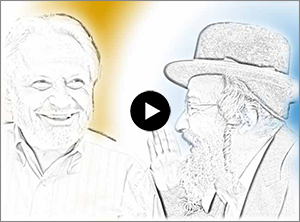Table Of Contents of my Passover Articles
- The Haftorah For Shabbos HaGadol, Serving G-d and Not Serving Yourself
- We’re Leaving Mitzrayim, Are You In?
- Why We Need The Symbols Of Slavery Also on the Table
- The Second Half Of Maggid Starting With “Metchila Ovday…”
- The Seder Night As the Vehicle of Passing Over the Tradition to the Children and Grandchildren
- A Collection of Individual Points on the Story of the Exodus
- More On The Passover Haggadah
- Seder Night and the Day After
- The Last Day of Pesach, What Was Revealed At the Splitting of the Sea
- Reciting Shiras Hayam Joyfully as if I Passed Through the Sea
Passover 2010
Passover this year, Passover 2010, starts at sundown Monday March 29, like every chag, (Jewish holiday), starts at sundown. Therefore the Passover Seder is done then on Monday night.
A major part of the Passover Seder is the reading of the Passover Haggadah, through which we fulfill the Mitzvah of the Torah, “You Shall Tell Your Son”, on Pesach.
Searching for Jewish Beliefs? Click Here for my main article on Jewish Beliefs.
Passover Haggadah
I am willing to share with my readers the special insights that I am planning on bringing out at my seder this year. Besides my standard explanations that I tell over every year, I have three points of inspiration that I want to give over to my family. One is for the grandchildren who are old enough to understand something, one is for my unmarried children, and one is for the married children.
For the grandchildren I want to get across to them that there is an expance of time, that once Zeidy was a child, etc. to show that Yetzias Mitzraim was a long time ago. And then, like every year, I explain what is an eved (doesn’t go to cheder, doesn’t get Bar Mitzva’ed, only works for the king all of his life) and what is a king (total rulership, life and death), etc. This I plan to say right after Avadim Hayinu LeFaroh BeMitzraim, which is the basic answer to the four questions, so it makes sense to explain to the grandchildren then whatever I want to explain.
For the unmarried children I want to speak out this year that besides the individual tikun that each person has to make, to be a good Jew and to be answerable for his actions, besides that there is a collective national tikun that is to be achieved. The original plan was to leave Mitzrayim, to go receive the Torah, and then to come to Eretz Yisroel to build a Bais HaMikdash which would accomplish basically the tachlis of creation, to create a conducive environment where the Divine Presence can dwell downstairs, thus creating a situation where Malchus Shamayim is revealed in a permanent way.
This was actually never accomplished, as there were a number of failures like the egel etc etc, (this is not the forum), and we are still waiting for this to happen, that there should be enough isarusa delesata to arouse isarusa dele’aila so that the promised awaited tachlis, the gevaldiga tshuka of both upstairs and downstairs since the 6 days of creation can finally come to be, in a complete way, and in a permanent way.
This I want to say when the Haggadah discusses the Bris Bain HaBesarim.
Then for the married children I want to point out what is lechora simple, just that for me it is an inspiration this year, as follows. Rav and Shmuel, whether what is supposed to be said (first) is the Ruchniusdika redemption or the physical redemtion.
What we actually do is that first we mention the physical, Avadim Hayinu, and then we mention the Ruchnius, Mitchila Ovday etc. I want to say that it is necessary that they go together, impossible one without the other. For whenever there is lacking in Ruchnius, in us as individuals or in us as a community, perforce we draw upon ourselves, we attach ourselves to, the you-know-what. And this manifests itself in the material world as golus and the like.
That’s why she’bechol dor vedor omdim alaynu lechalosaynu, it has to be that way, because as long as we are not doing our duty to rise up to perfection, then perforce we are in the lion’s jaws, and it will continue that way until the end of the final golus, when it will be accompanied with the achievement of spiritual perfection. Therefore both aspects of redemption must be accompanied by one another.
It says in sefarim that the redemption from Mitzrayim was via dilugim, that we weren’t really ready for it. Rather it was a bechina of Shabbos, “memacharas haShabbos”, isarusa dele’aila. Nissan is the chodesh where yeshuos makifos. Some transalate it like hakafa, buying on credit, getting something and paying for it later. The sheva Shabbosos Temimos of working on ourselves until Matan Torah.
This I want to explain this when we get to Mitchila, where I explain Rav and Shmuel.
I will share one more thought. If you would interview a young man there in the Midbar, where were you born? He’ll say, well, I was born in Chatzairot, but my family moved along with everyone else, and now we’re all living in Chashmona. Ask him, so what’s the plan? And he’ll answer, I don’t know what to tell you, they say that we’re going to Eretz Yisroel, but ich vais nisht, so far I don’t see anything going in that direction. They say that we made a p’gam and we’re being punished, and it’s going to take some time, 40 years they say, but I don’t know what to tell you, ever since I remember we’re going around in this Midbar, I don’t know if we’ll ever make it to Eretz Yisroel, I just don’t see the end of the tunnel.
We who live after would say to that young man, of course you’re going to Eretz Yisroel, and of course it’s only going to be 40 years, why should you let it shter your emunah because you haven’t seen it yet? It’s so clear, don’t you see it?
HaKodosh Boruch Hu chishev es haKaitz. Anything that is no good has an end. Kaitz sam le’choshech.
“Like in the days that you went out of Mitzraim I will show them wonders”.






Leave A Response